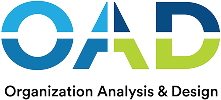A job description is more than a checklist—it’s the first impression your company makes on potential hires. In today’s competitive market, knowing how to write a job description that is clear, compelling, and science-backed can be the difference between attracting top talent or losing them to other employers. When crafted strategically, it becomes the foundation for hiring success, aligning the right candidates with your mission, culture, and growth.
Table of Contents
- Core Elements of an Effective Job Description
- Crafting Clear Job Titles and Summaries
- Defining Responsibilities and Skills
- Legal, Compliance, and Accessibility
- Showcasing Culture and Growth Opportunities
- Writing with Clarity and Impact
- Ending Strong: The Call to Action
- Effective Job Description Examples
- The OAD Advantage
Too often, companies underestimate the impact of job descriptions, treating them as administrative paperwork rather than strategic tools. But research shows the cost of a bad hire can reach 30% of that employee’s annual salary (U.S. Department of Labor), especially when job descriptions fail to clearly define employee responsibilities and legal expectations.
Effective job descriptions are essential for attracting qualified candidates and reducing costly hiring mistakes.
A generic job post attracts generic applications. The right description, however, acts like a filter—drawing in qualified candidates while naturally discouraging misaligned applicants. It’s the difference between sifting through hundreds of résumés and engaging directly with the few who are truly right for the role.
As Jeff Bezos once remarked, “I’d rather interview fifty people and not hire anyone than hire the wrong person.” A science-backed job description is the first step toward making sure you hire right the first time.
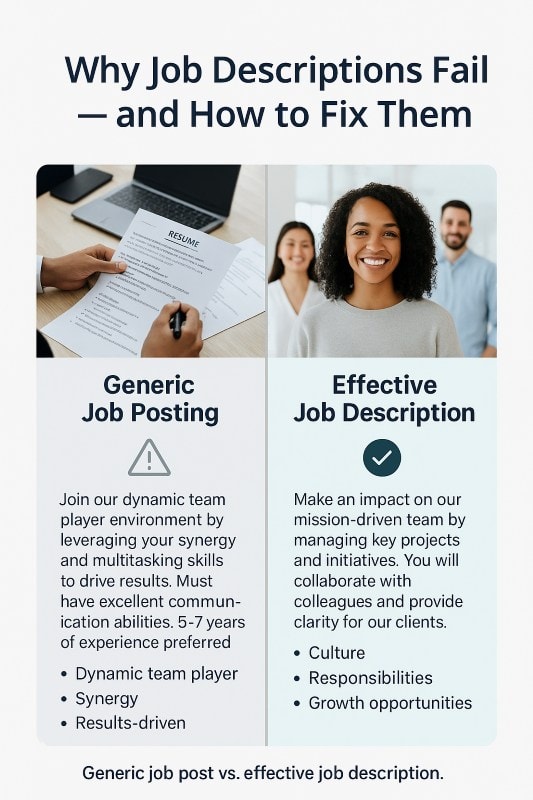
Core Elements of an Effective Job Description
Every effective job description has four essential building blocks. For clarity, consider the following definitions:
1. Job Title – The headline of the role. It should be clear, searchable, and accurately reflect the responsibilities and level of the position. Selecting the right job title helps ensure the position attracts candidates with the appropriate experience and education.
2. Job Summary – A short overview that communicates the role’s purpose, how it supports company goals, and what makes it compelling for job seekers.
3. Key Responsibilities – The core responsibilities and job responsibilities the role performs. Clearly outlining these main duties and daily activities helps candidates understand expectations and the organizational context. Use action verbs and present tense so candidates can immediately envision their day-to-day activities.
4. Qualifications – A balanced list of must-have and preferred qualifications. Include both technical skills required and soft skills, but avoid long, exclusionary lists that might scare off qualified candidates. Specify the experience and education needed for the position.
When these four pieces work together, they transform a job posting from a simple advertisement into a roadmap for success—for both the company and the candidate.
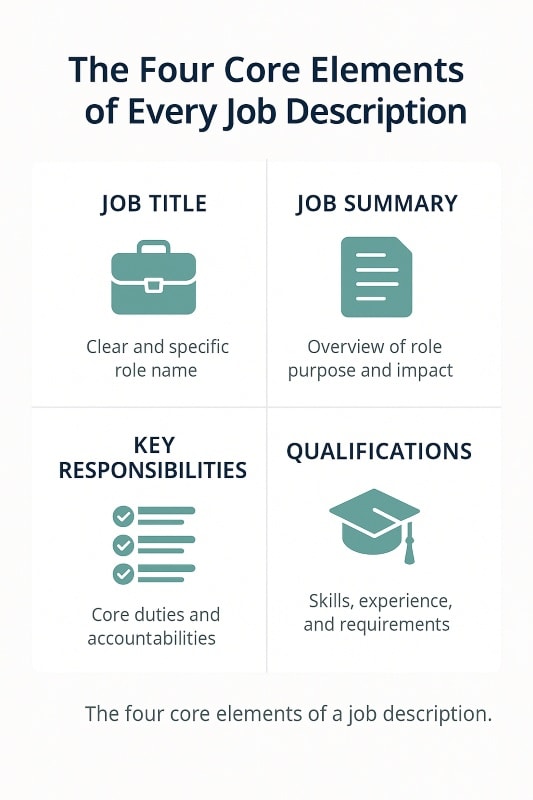
Crafting Clear Job Titles and Summaries
The job title is often the first thing a job seeker sees—and it can determine whether they even click on your posting. A vague label like “Specialist” or “Coordinator” might look tidy on an org chart, but it doesn’t speak to what the role actually entails. Compare that with “Digital Marketing Strategist” or “Senior Client Success Manager.” The latter set expectations clearly, draw in the right candidates, and filter out applicants who aren’t a fit.
When defining responsibilities, it’s important to distinguish between essential duties and marginal duties. Essential duties are the critical job duties that are fundamental to the role, while marginal duties are peripheral or non-essential tasks. Clearly identifying which responsibilities are essential helps ensure candidates understand the core requirements of the position.
The job summary serves a different purpose. Instead of rehashing duties, it should answer why this role exists and how it connects to your company mission. This is where you can differentiate your organization from other employers. A compelling summary highlights the role’s impact and gives candidates a reason to see themselves in your culture and vision—not just your tasks. Be sure to outline the specific job duties that are critical to the role.
When listing qualifications, include required skills, required knowledge, required licenses, and education as key components. Knowledge should be specified as it relates to education, experience, and skills necessary for success in the role.
When done well, the title attracts attention, and the summary sustains it. Together, they establish both clarity and inspiration from the very start of the hiring journey. Be sure to include a statement about other duties to cover additional responsibilities that may not be explicitly listed.
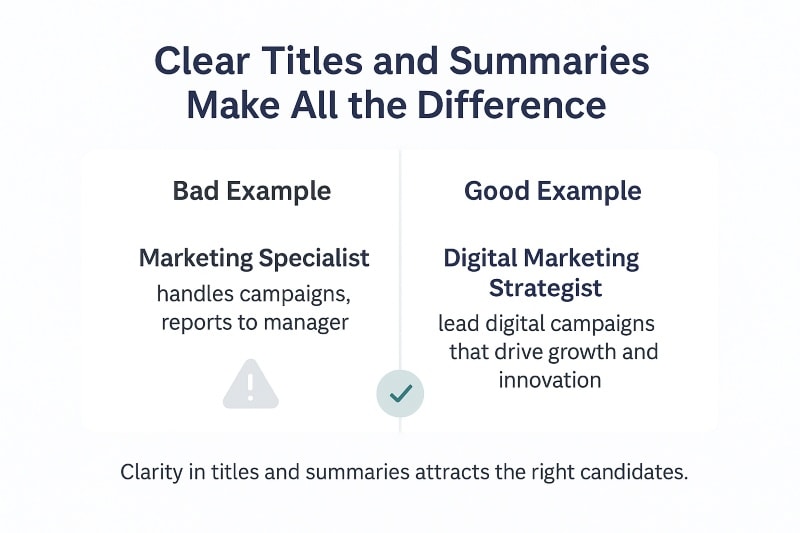
Defining Responsibilities and Skills
One of the most common mistakes hiring managers make is overloading job descriptions with endless bullet points. While it may feel comprehensive, an exhaustive list of tasks can overwhelm job seekers and deter qualified candidates. The goal is not to describe every possible duty but to spotlight the key responsibilities that define success in the role. Clearly defining the level of responsibility and the specific work performed by each employee is essential for legal compliance and clarity. Use present tense and action verbs—“lead,” “develop,” “coordinate”—to keep responsibilities clear and engaging.
When it comes to qualifications, research shows that overly long requirements lists disproportionately discourage women and underrepresented groups from applying (LinkedIn, 2019). A better approach is to separate must-have qualifications from nice-to-have skills. Keep the essentials—like certifications, technical skills required, or minimum years of experience—distinct from qualities that would be beneficial but not mandatory. Well-structured job descriptions help set clear expectations for employees and ensure that each employee understands the work performed and their responsibilities, supporting ADA compliance and other legal requirements.
Finally, remember that top talent is not defined by hard skills alone. Behavioral science consistently shows that soft skills—like problem solving, collaboration, and communication—are just as critical in predicting long-term performance. Highlighting both hard and soft skills helps you attract well-rounded candidates who can thrive in your team environment and ensures employees are aware of the full range of expectations for the role.
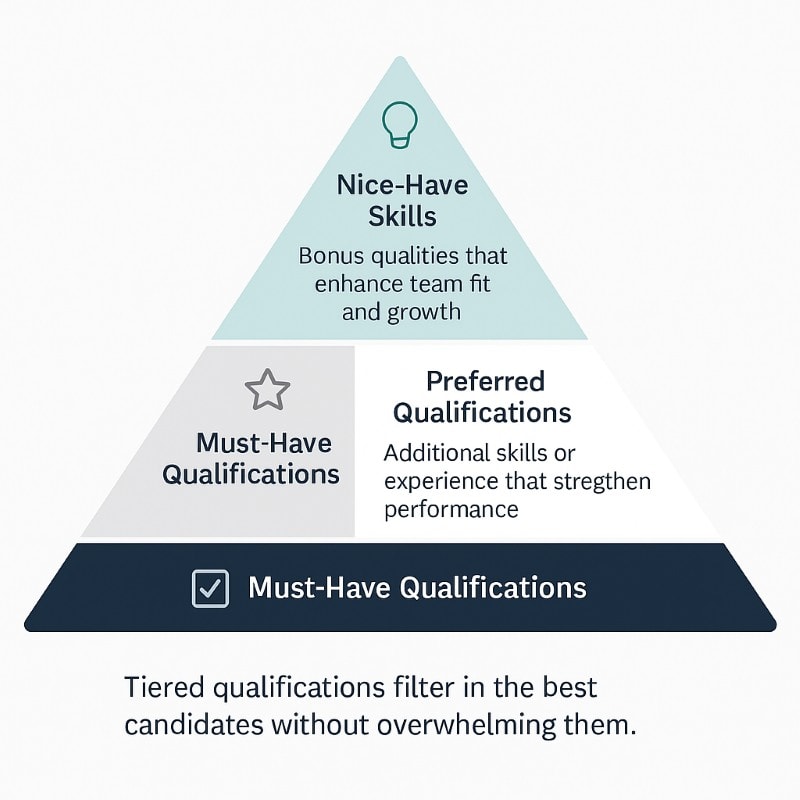
Legal, Compliance, and Accessibility
Even the most compelling job description can create risk if it overlooks legal and compliance requirements. HR leaders must ensure postings align with regulations like the Americans with Disabilities Act (ADA), which requires job descriptions to outline any physical requirements or essential functions in a way that is inclusive and non-discriminatory. Addressing these aspects ensures that employees are aware of the company’s commitment to fair treatment and a supportive work environment, which can enhance employee satisfaction and retention.
Avoid ambiguous terms such as “must be physically fit” or “young and energetic,” which can introduce bias and exclude qualified candidates. Instead, describe requirements factually and in line with the actual work environment—for example: “ability to lift up to 20 pounds occasionally” or “role involves regular use of computer equipment.”
Finally, include mention of working conditions (e.g., remote flexibility, travel expectations, shift requirements) to help candidates understand the realities of the role. Transparency not only keeps you compliant but also builds trust with potential hires.
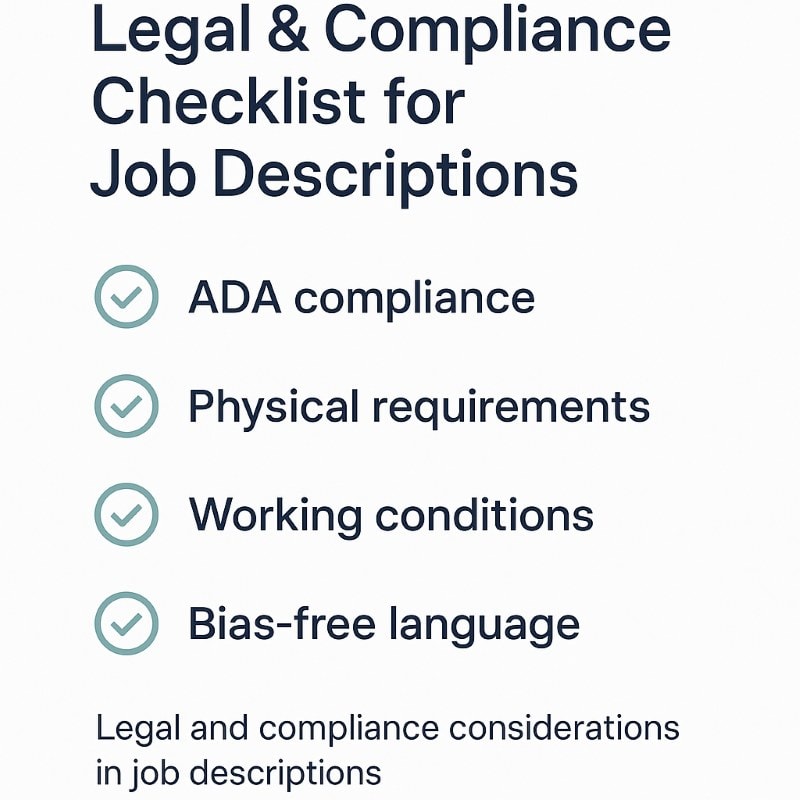
Showcasing Culture and Growth Opportunities
For today’s job seekers, salary alone isn’t enough. High performers want to know what it feels like to work at your company and how the role connects to their long-term goals. To attract the best candidates, it’s essential to know how to write a job description that clearly communicates your company’s unique value and the opportunities available. A well-crafted description should highlight both your company culture and the growth opportunities tied to the position.
Think beyond perks. Instead of generic lines like “fast-paced environment,” emphasize your mission, values, and the impact the role has on the organization. Starbucks, for example, consistently reinforces its culture of community and service, which attracts candidates aligned with those values.
Equally important is showing candidates how they can develop within the role. Whether it’s exposure to cross-functional teams, leadership pathways, or high-impact projects, growth opportunities give top talent a reason to choose your company over other employers. These principles apply when you write a job or write a job description for different jobs and roles, ensuring clarity and impact across your listings.

Writing with Clarity and Impact
The language you choose shapes how candidates perceive the role. Weak, passive phrasing like “responsible for team oversight” feels vague and uninspiring. Instead, use clear, action-oriented language: “Lead a high-performing team to deliver projects on time and within budget.” The difference is subtle but powerful—it signals ownership, accountability, and purpose.
Always write in the present tense. This creates immediacy and helps candidates envision themselves performing the role: “Develop strategies,” “Collaborate with cross-functional teams,” “Analyze results.”
Readability also matters. Break up dense sections with bullet points when listing skills, qualifications, or responsibilities. Provide enough detail to set expectations without overwhelming candidates with a comprehensive list of every possible task. The goal is clarity, not clutter.
Effective job postings also end with a strong call to action, encouraging candidates to apply. Studies show that job postings with clear CTAs increase engagement and application rates.
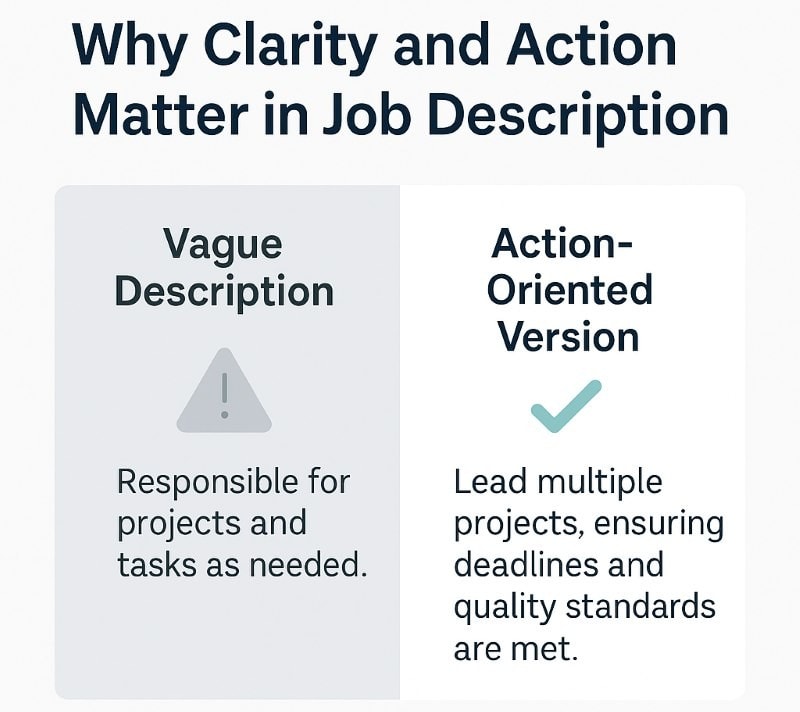
Ending Strong: The Call to Action
Even the best-crafted job description can fall flat if it ends without direction. A clear call to action (CTA) guides qualified candidates toward the next step.
Avoid generic phrases like “submit your application”. Instead, frame the CTA as an invitation to impact and grow:
- “Apply today to help shape our next stage of growth.”
- “Join us and make a measurable difference from day one.”
The tone should reflect your culture. A startup might emphasize innovation and ownership, while a more established company may highlight stability and long-term growth. Either way, the CTA should leave candidates motivated to act, not uncertain about what comes next.
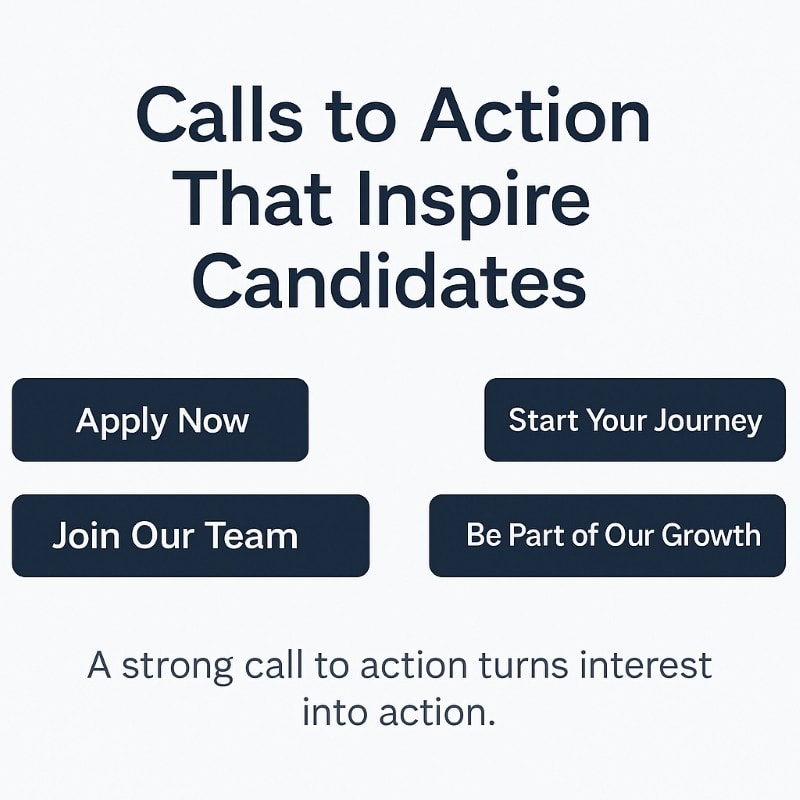
Effective Job Description Examples
Crafting an effective job description is both an art and a science. The best job descriptions combine clarity, detail, and a sense of what makes your company unique. Here are some examples to inspire your next job posting:
- Job title: Use a clear, keyword-rich job title like “Marketing Manager” or “Software Engineer” to ensure your posting is easily found by job seekers.
- Job summary: Start with a concise summary that outlines the main responsibilities and impact of the role. For example: “We are seeking a marketing manager to lead our marketing team and develop campaigns that drive sales and revenue growth.”
- Job duties: Use bullet points to list the core responsibilities, such as:- Develop and implement marketing campaigns
- Manage social media accounts
- Analyze marketing metrics and adjust campaigns accordingly
- Requirements: Clearly state the minimum qualifications, such as:- Bachelor’s degree in marketing or related field
- 3+ years of marketing experience
- Proficiency in marketing software and tools
- Company culture: Give candidates a sense of your work environment, for example: “We are a fast-paced and dynamic company that values innovation and creativity.”
By following these examples and including enough detail, you’ll create effective job descriptions that attract qualified candidates and set the stage for a successful hiring process.
The Human Resources Role in Job Descriptions
Human resources professionals are at the heart of creating effective job descriptions that attract top talent and ensure legal compliance. A good job description is the result of collaboration between HR, the hiring manager, and other key stakeholders, ensuring that every detail accurately reflects the job duties and responsibilities.
Job Descriptions and SEO: Maximizing Reach
In a competitive hiring landscape, even the best-written job description won’t attract top talent if it’s hard to find. Optimizing your job descriptions for search engines is essential to ensure your job posting reaches the widest pool of potential candidates. By using SEO best practices, you can increase the visibility of your job postings and connect with job seekers who are actively searching for roles like yours.
Company Information: Presenting Your Brand
A compelling job description is more than a list of job duties—it’s a window into your company’s brand and culture. Today’s job seekers want to know not just what they’ll do, but where they’ll do it and why it matters. By weaving company information into your job descriptions, you help candidates understand your mission, values, and what sets your workplace apart.
Salary and Compensation: Setting Expectations
A good job description does more than outline responsibilities—it sets clear expectations for potential candidates, especially when it comes to salary and compensation. Including this information up front helps job seekers quickly determine if the position aligns with their financial goals, saving time for both the company and applicants. In fact, a 2019 Indeed survey found that nearly 70% of candidates rarely or never saw salary details in job descriptions, making transparency a key differentiator for employers looking to attract top talent.
The OAD Advantage
A well-written job description sets the stage, but it’s only the first step. To truly secure the most qualified candidates, you need more than words on a page—you need insight into how each applicant will actually perform once hired.
That’s where OAD comes in. Our science-backed personality and talent assessments go beyond résumés and interviews to reveal the behavioral traits, decision-making styles, and communication strengths of each candidate. This ensures you’re not only attracting the right people but also aligning them with the roles where they’ll thrive. Human resources professionals can leverage these resources to enhance their hiring and recruitment processes, making it easier to identify and select top talent.
The result? Lower turnover, stronger team performance, and hires that fit seamlessly into your company culture.
Test OAD for free and see how behavioral data transforms good hiring into great hiring.
